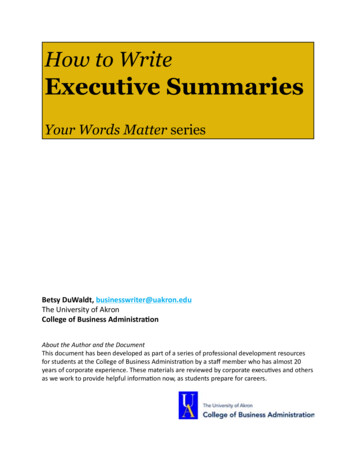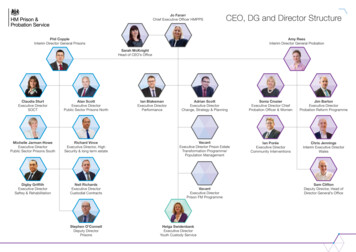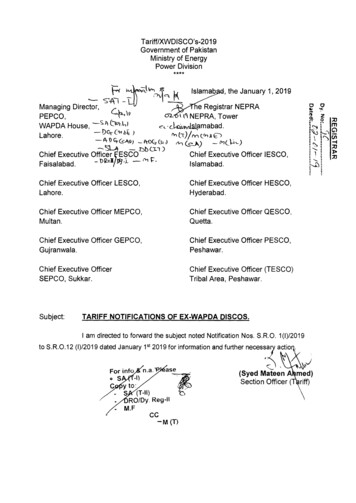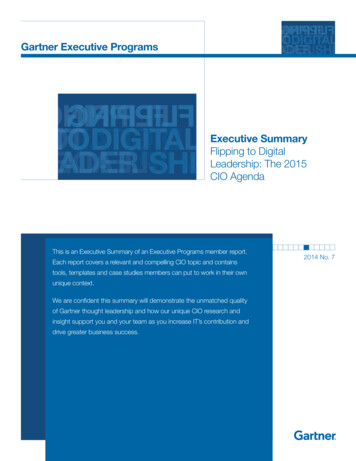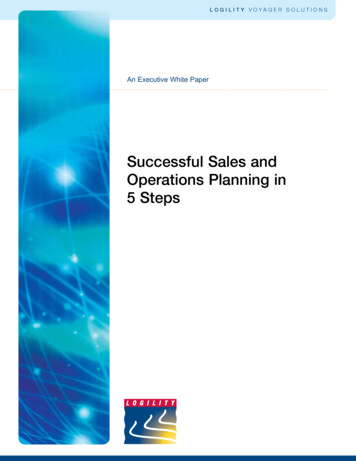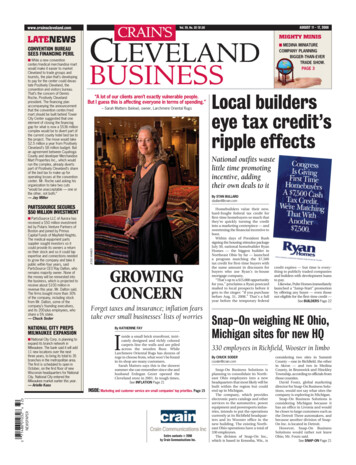
Transcription
InspiringBusinessPerformanceAn Executive Guide to theOliver Wight Maturity ModelThe journey to business excellence
To continue to meet customer demand in today’s constantly evolvingmarket you need to keep improving. But attempting to make gains, simplyby introducing the latest on-trend initiative is likely to end only in failure,disillusionment and significant cost. It is vital to make the right improvements atthe right time, and in the right order.The Oliver Wight Maturity Model identifies your organisation’s real level ofmaturity, helping you understand where your business is, and where you needto be so you can nurture, measure and celebrate your progression on thejourney to business excellence.1
Understanding your business maturityIn our consumer-driven business climate,the most successful organisations arethose that are able to not only meetcustomers’ needs effectively and profitablynow, but also in five, 10 and 15 yearstime. This requires a relentless programmeof improvement to continually increaseperformance levels.Herein lies the danger; unless yourbusiness is truly ready to effectively deployand support that initiative or system,the results will be limited at best. Morelikely, they will be short-term and theorganisation will revert to its previousstate, with only significant cost anddisillusionment to show for its efforts.However, faced with increasing demandsfrom customers and shareholders - shorterlead times, lower prices, more profit organisations often reach in desperation,for the latest ‘flavour of the month’ initiativeor IT system to improve performance.By understanding the true maturity ofyour organisation, you can sow theseeds of success by making the rightimprovements, in the right place, at theright time.2
What is the Oliver Wight Maturity Model?Developed by Oliver Wight from a HarvardBusiness School study for the USGovernment in 1985, the Maturity Modelallows you to identify your organisation’sreal level of maturity. Using it to test yourpeople and their behaviours, and yourprocesses and tools, against a set ofmeasurable criteria, you can determineyour business’s true capability andreadiness for improvement.The Oliver Wight Maturity Modelcharacterises businesses as being inone of four key phases of maturity andFigure 1 - The Oliver Wight Maturity map3determines what is required for theorganisation to progress from one phase tothe next (see the maturity map in figure 1).Only by accepting the reality of this level ofmaturity - and that improvement is a longterm journey, not a short-term initiative- can your business begin to prepare itselffor the performance levels it aspires to.It then becomes a matter of sequencingthe appropriate steps for the improvementjourney - once you know where you areand where you want to be, the next step isto understand how to get there.
The maturity journeyPhase 1First, as a company progresses from thebottom to the top of phase 1, behaviours,processes and tools are improvedsufficiently to gain control and eliminateunplanned events, thus delivering aminimum performance level of 95 percent.Phase 2Once this level is achieved and can besustained, the next step on the journeyis the simplification and removal of wastein processes, whilst increasing customerservice levels. At the top of phase 2companies operate to a level of 250 partsper million defect opportunities.Phase 3Phase 3 focuses on taking knowledgebased business processes and, whereappropriate (based on the requiredinvestment and market needs), automatesthem to further increase velocity andreduce the need for manual intervention.Resulting in a further step change inperformance, this next maturity levelmust be decided upon according to thebusiness drivers and strategic intent.Phase 4Finally, in phase 4, automated businessprocesses are fully integrated withtechnology; this is often characterised by‘lights-out factories’ where robots havereplaced traditional blue-collar teams.Again, this change in maturity must bebased on competitive advantage as wellas a cost-effective response to actualcustomer needs and a real understandingof the value they anticipate.4
Figure 2 - The maturity journey for Integrated Business PlanningTransformation through transition5This progression from one phase to thenext is not made in a single step but bya series of transitions, each of whichsees a transformation in the organisation.It is important to understand too, thatbetween 85 and 90 percent of businessesare distributed throughout phases 1and 2. Consequently, only a handful oforganisations worldwide can truly describethemselves as phase 4 companies.70 up to 95 percent, which in turn brings asubstantial productivity improvement.There are five transitions a company needsto make before it reaches the top of phase2. A business transformation from thebottom to the top of phase 1 (eliminatingunplanned events to gaining control) marksa performance improvement from aroundupdated, these are all aligned with theOliver Wight Class A Checklist for BusinessExcellence and associated MilestoneWorkbooks, so an organisation can steer,measure and celebrate its progressionthrough its maturity journey.Over the last decade, Oliver Wight hasdeveloped a comprehensive portfolioof transition diagrams - like the one forIntegrated Business Planning shownin figure 2 - relating to all the keybusiness processes, people and teams,organisational dynamics, performancemanagement and so on. Continually
It’s all about timingIn contrast to the maturity model, aninitiative-based approach to business israther like beginning a journey withoutknowing the final destination, or even thestarting point (try this with your Satnavand see where it gets you). Typically therewill be many false starts with no realcompletion in terms of establishing a newway of doing business.Crucially, if the business is not matureenough for the initiative then it will achievesome success only while it enjoysmanagement focus, but as soon as thatfocus shifts, success falls away. That is notto say, improvement initiatives have no roleto play; it’s all about timing.lean principles when a company is inphase 1 can only be done functionallyand companies typically only gain a 4 or5 percent improvement. Applying lean inphase 2, however, when an organisationhas designed and gained control overits end-to-end business processes,means it can span the gaps traditionallyleft between functions, thereby boostingimprovement levels to 30 or 40 percent.The Oliver Wight Maturity Model pitchesyour organisation in the correct phase, soyour senior executive can truly understandwhere the business sits, visualise thebenefits a structured improvementprogramme can bring, and propagate thejourney to business excellence.Whether continuous improvement, Lean,Six Sigma or any other technique, thereis a logical sequence to the applicationof every improvement initiative and theyshould be managed with a structuredprogramme based on the maturity of thebusiness. The order of their applicationwill govern the long-term success. Thetools are all valuable in their own right,but they require the necessary roots tobe sustainable. For example, applying6
InspiringBusinessPerformanceAt Oliver Wight, we believe sustainable business improvement can only bedelivered by your own people; so, unlike other consultancy firms, we transfer ourknowledge to you. Pioneers of Sales and Operations Planning and originators ofthe fundamentals behind supply chain planning, Oliver Wight professionals are theacknowledged industry thought leaders for Integrated Business Planning (IBP).Integrated Business Planning allows your seniorexecutives to plan and manage the entireorganization over a 24-month horizon, whileOliver Wight’s extended Supply Chain Planningand Optimization ensures your supply chain isdesigned and structured to deliver best-in-classcustomer service with minimal costs. Usingthe Oliver Wight Maturity Model to pursue ourglobally recognized Class A standard for bestOliver Wight EAME LLPThe WillowsThe Steadings Business CentreMaisemoreGloucester, GL2 8EYUnited Kingdompractice will determine a tailored improvementjourney for you to develop your organization’sprocesses, and reach and sustain excellentbusiness performance. With a track recordof more than 40 years of helping some of theworld’s best-known organizations, Oliver Wightwill help you define your company’s vision forthe future and deliver performance and financialresults that last.Oliver Wight Asia/Pacific131 Martin Street, BrightonVictoria 3186, AustraliaT: 44 (0)1452 397200email@oliverwight-eame.comOliver Wight AmericasP.O. Box 368, 292 Main Streetwww.oliverwight-eame.comNew London, NH 03257, USAThe information contained is proprietary to Oliver Wight International and may not be modified,reproduced, distributed or utilized in any manner in whole or in part, without the express prior writtenpermission of Oliver Wight International.
Oliver Wight s extended Supply Chain Planning and Optimization ensures your supply chain is designed and structured to deliver best-in-class customer service with minimal costs. Using the Oliver Wight Maturity Model to pursue our globally recognized Class A standard for best practice wil


